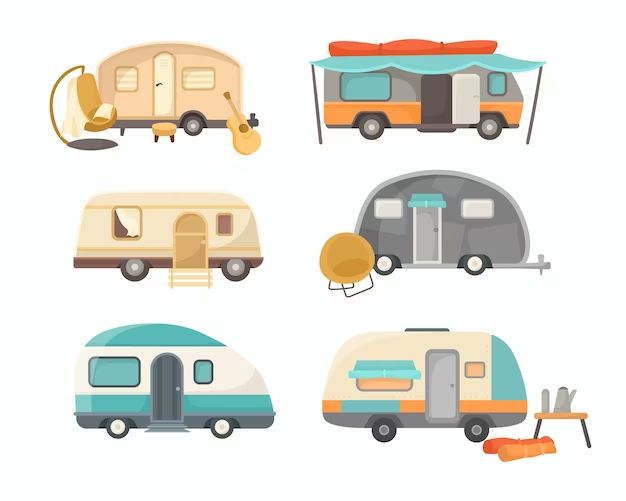When setting up a camper, one of the most important considerations is what to put underneath it. Having the right base underneath your camper is crucial for stability, leveling, and protecting the camper from damage. In this article, we’ll go over the different options for camper bases and what you should put underneath a camper.
Page Contents
Using Camper Jack Pads
One of the most common and affordable options for creating a base under your camper are camper jack pads. These are thick, rubberized pads that go under your camper’s stabilizing jacks to prevent them from sinking into soft ground. Here are some key things to know about jack pads:
- They come in various sizes, shapes, and weights. Look for a size that fits your jack footprint.
- The pads spread the jack’s weight over a larger surface area to prevent sinking.
- They provide protection for delicate surfaces like asphalt.
- Jack pads are very portable and stow away easily.
- Levels of thickness range from 1/2 inch to 2 inches.
Camper jack pads are an inexpensive way to provide a stable, protective base under your stabilizing jacks. Just be sure to get a large enough size and use pads under each jack for maximum stabilization.
Using Camper Leveling Blocks
Another common option for base support under a camper are camper leveling blocks. These are molded plastic or vinyl blocks that go under your camper’s tires to level and stabilize it. Here’s what to know about leveling blocks:
- They come sized specifically for camper tires, usually 8-10 inches tall.
- Leveling blocks lift the wheels to stabilize on uneven sites.
- Blocks are stacked in pyramids to reach the needed height.
- High-quality blocks feature beveled edges for easy ramping.
- Look for interlocking blocks that prevent sliding and shifting.
Leveling blocks provide an adjustable, portable way to create a stable base. Use them under all tires or just the low side to easily level your camper.
Trying Camper Leveling Ramps
For campers with very low ground clearance, you may need camper leveling ramps instead of blocks. Here are the benefits of ramps:
- Provide a smooth incline for low-clearance RVs.
- Allow you to drive up onto blocks without bottoming out.
- Usually made from thick plywood or plastic.
- Some designs can bolt together for adjustable widths.
- Pair with blocks to lift wheels and level the camper.
Ramps prevent damage from bottoming out and make leveling easier. Measure your RV’s clearance to see if ramps are needed.
Using Ground Protection Mats
In addition to jack pads, many RVers use ground protection mats under the entire length of the RV. Here’s when you may want mats:
- Protect delicate grass or vegetation from damage.
- Prevent tires from sinking in soft ground like sand or mud.
- Provide a smooth, level surface on uneven sites.
- Defend against moisture, mildew, and rotting wood floors.
- Options like plywood sheets are inexpensive.
Mats provide a protective barrier between your camper and the ground. They help stabilize and prevent shifting on soft surfaces.
Using Wheel Chocks
Once your camper is leveled and blocked, be sure to use wheel chocks for added stabilization. Wheel chocks lock in place behind the tires to prevent rolling. Things to know about chocks:
- Made of rubber, plastic, or wood materials.
- Designed to fit snugly behind tires to prevent rolling.
- Should be used on both sides of one wheel.
- Chocks with adjustable length work for various RV tire sizes.
- Look for a rugged, triangular design that won’t shift or slip.
Properly placed wheel chocks provide an extra sense of security and stability when camping. Don’t forget this essential final step when setting up.
Using Screw Jacks for Stabilizing
Campers with manual or electric screw jacks at the corners can use those instead of stabilizing jacks. Here are advantages of using screw jacks:
- They are permanently attached and often more heavy duty.
- Electric models allow you to stabilize without manual cranking.
- Corner screw jacks lift the camper slightly for rock solid stability.
- Levels your RV by adjusting each jack individually.
- Combine with pads or blocks under the jacks/feet.
Built-in electric or manual screw jacks provide great stabilization. Just remember to use pads and extend them fully when setting up.
Considerations With Different Terrains
The type of terrain you’re camping on may require some special considerations or equipment. Here are some tips:
- Soft ground: Use larger, more sturdy pads or thick plywood sheets.
- Pavement: Ensure rubber pads are used to prevent damage.
- Gravel: Try to park on the flattest, most packed area if no pads.
- Hillsides: Level side-to-side and use extended screw jacks for stability.
- High winds: Use wheel chocks and screw all stabilizers into the ground.
Take a look at the campsite surface and make sure your camper base setup is right for the conditions.
Conclusion
Having the proper base under your camper is critical for keeping it secure and preventing damage. While camper jack pads, leveling blocks, and mats are great basic options, also consider ramps, wheel chocks, and built-in jacks depending on your specific needs. Take into account the surface you’re parking on and get the right gear for optimal stability. With the right setup underneath, you can feel confident your camper will be protected on any camping trip.
